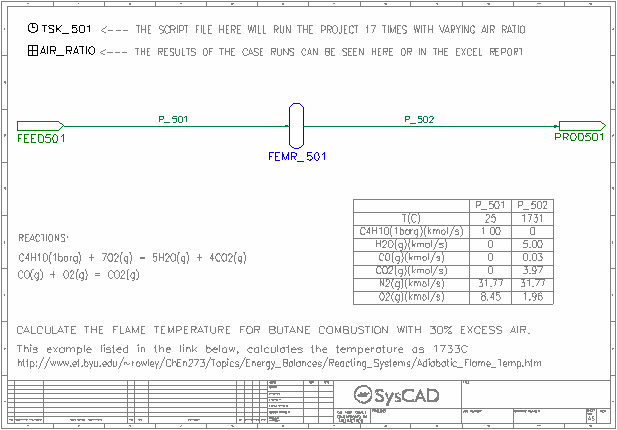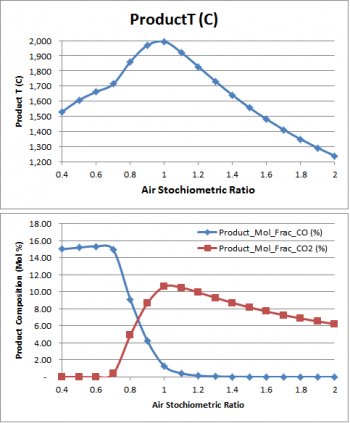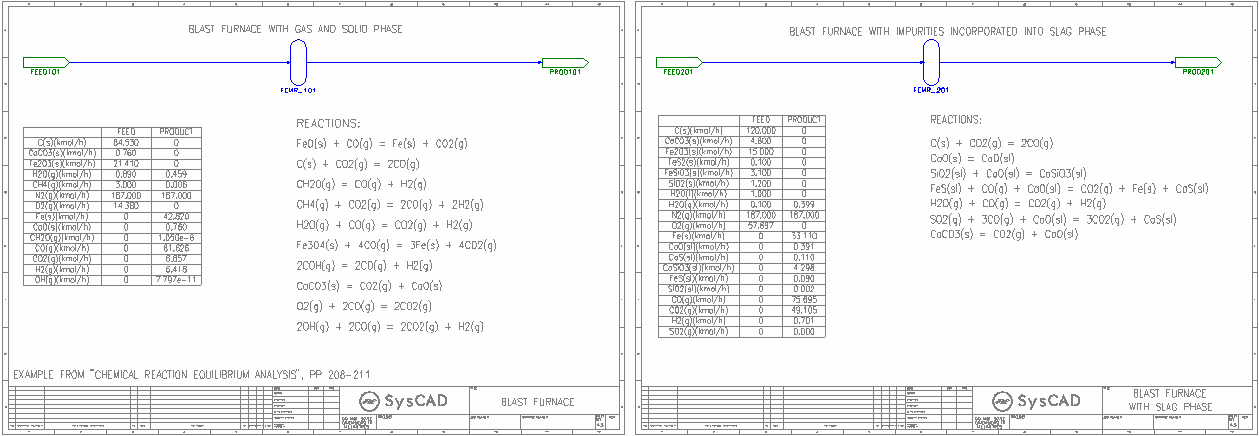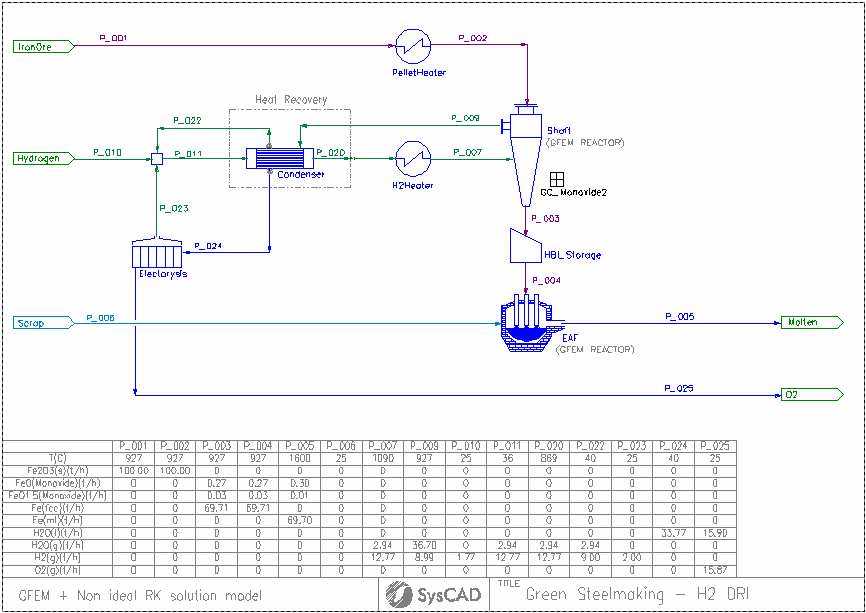Example - GFEM Projects: Difference between revisions
Merry.Huang (talk | contribs) |
Tanai.Marin (talk | contribs) (Updated screenshot for Green Steelmaking Example, Added more description.) |
||
| Line 69: | Line 69: | ||
== GFEM + RK Binary Model - Green | == GFEM + RK Binary Model - Green Steelmaking Example == | ||
[[File:H2 DRI | [[File:66 Steelmaking H2 DRI GFEM RK.png|1000 px|none|H2 Direct Reduction of Iron Steelmaking]]<br> | ||
'''Project Location''' | '''Project Location''' | ||
| Line 79: | Line 79: | ||
''' Features Demonstrated ''' | ''' Features Demonstrated ''' | ||
Shows how to use '''Gibbs Free Energy Minimisation''' (Gibbs FEM) Reactors with non-ideal solution models by adding automatic calculation of activity coefficients for the monoxide phase in a PGM (General Controller) as a function of composition and temperature using R-K (Redlich-Kister) model.<br> | |||
Use of magnetic ordering parameters for Gibbs Energy equations for Fe (bcc and fcc) and Spinel (Fe3O4) compounds.<br> | |||
''' Brief Description ''' | ''' Brief Description ''' | ||
The model consists of a high-level DRI (Direct Reduction of Iron) process driven by H<sub>2(g)</sub> reduction. The iron ore feed consist of hematite (Fe<sub>2</sub>O<sub>3</sub>) at a mass flow rate of 100 t/h.<br> | |||
Excess pre-heated hydrogen gas is necessary to be provided to the shaft furnace to drive the reduction reaction from monoxide (FeO solid solution) to metallic Fe (bcc or fcc) due to thermodynamic constrains.<br> | |||
The Shaft furnace off-gas contains a significant fraction of un-used H<sub>2(g)</sub> that needs to be recycled and H<sub>2</sub>O<sub>(g)</sub> resulting from the reduction reactions. However, the water vapor must be condensed and removed from the recirculating gas by means of heat exchangers.<br> | |||
The condensed water from the off-gas is electrolyzed to regenerate H<sub>2(g)</sub>. Since this process is not 100% efficient, make-up hydrogen (fresh feed) is necessary to balance the process requirements.<br> | |||
The hot reduced iron product from the shaft furnace are feed into an electric arc furnace (EAF) where it can be melted alongside recycled scrap.<br> | |||
The shaft furnace and EAF are GFEM reactors. The shaft furnace includes PGM code (General Controller) to add functionality describing the non-ideal behavior of the binary solid solution model for monoxide (FeO - FeO<sub>1.5</sub>). This model is necessary to correctly predict the boundary line between FeO/Fe reduction at the correct H2/H2O ratio.<br> | |||
''' Project Configuration ''' | ''' Project Configuration ''' | ||
Revision as of 18:25, 28 August 2023
Navigation: User Guide ➔ Example Projects ➔ 03 UnitModels: Gibbs FEM Projects
Related Links: Reactor (Gibbs FEM)
FEM Simple Examples
- (NOTE: not all the flowsheets are shown here)
Project Location
..\SysCADXXX\Examples\03 UnitModels\FEM Simple Examples.spf
Features Demonstrated
Shows how to set up simple Gibbs Free Energy Minimisation (Gibbs FEM) Reactors.
Brief Description
This project has five flowsheets:
- Single Reform Reaction
- Shows how to set up a single reaction in the Gibbs FEM reactor, this is compared to using the reaction block.
- Multi Species Reform Reaction
- Shows how to set up the Gibbs FEM where two reactions are present.
- Hydrazine Combustion
- Shows how to set up the combustion reactions. This example highlights an issue where chemical potential values may need to be overridden due to poor data in the database at very high temperatures.
- Vapour Liquid Equilibrium
- Shows how the Gibbs FEM reactor can be set up to find VLE or Boiling point of mixtures.
- Adiabatic Flame Temperature
- Shows how the Gibbs FEM reactor can be set up to find the adiabatic flame temperature.
- This page also shows the CO and CO2 fraction change based on feed air ratio.
Project Configuration
The project configuration has been described in detail in the SysCAD Supplementary Tutorial - Gibbs FEM.pdf.
Included Excel Report
CO & CO2 Composition.xlsx - This workbook contains results from the Adiabatic Flame Temperature flowsheet.
FEM Blast Furnace Examples
Project Location
..\SysCADXXX\Examples\65 Smelting\FEM Blast Furnace Examples.spf
Features Demonstrated
Shows how to set up Blast Furnace using Gibbs FEM reactors.
Brief Description
This project has two flowsheets:
- Blast Furnace
- Shows how to set up the blast furnace reactions using the Gibbs FEM reactor, this page considers only the solid and gas phase.
- Blast Furnace with Slag
- Shows how to set up the blast furnace reactions using the Gibbs FEM reactor, this page has included the impurities into the slag phase.
Project Configuration
The project configuration has been described in detail in the SysCAD Supplementary Tutorial - Gibbs FEM.pdf.
GFEM + RK Binary Model - Green Steelmaking Example
Project Location
This is a Steady State project and is stored at:
..\SysCADXXX\Examples\66 Steelmaking\Green Steelmaking Example.spf
Features Demonstrated
Shows how to use Gibbs Free Energy Minimisation (Gibbs FEM) Reactors with non-ideal solution models by adding automatic calculation of activity coefficients for the monoxide phase in a PGM (General Controller) as a function of composition and temperature using R-K (Redlich-Kister) model.
Use of magnetic ordering parameters for Gibbs Energy equations for Fe (bcc and fcc) and Spinel (Fe3O4) compounds.
Brief Description
The model consists of a high-level DRI (Direct Reduction of Iron) process driven by H2(g) reduction. The iron ore feed consist of hematite (Fe2O3) at a mass flow rate of 100 t/h.
Excess pre-heated hydrogen gas is necessary to be provided to the shaft furnace to drive the reduction reaction from monoxide (FeO solid solution) to metallic Fe (bcc or fcc) due to thermodynamic constrains.
The Shaft furnace off-gas contains a significant fraction of un-used H2(g) that needs to be recycled and H2O(g) resulting from the reduction reactions. However, the water vapor must be condensed and removed from the recirculating gas by means of heat exchangers.
The condensed water from the off-gas is electrolyzed to regenerate H2(g). Since this process is not 100% efficient, make-up hydrogen (fresh feed) is necessary to balance the process requirements.
The hot reduced iron product from the shaft furnace are feed into an electric arc furnace (EAF) where it can be melted alongside recycled scrap.
The shaft furnace and EAF are GFEM reactors. The shaft furnace includes PGM code (General Controller) to add functionality describing the non-ideal behavior of the binary solid solution model for monoxide (FeO - FeO1.5). This model is necessary to correctly predict the boundary line between FeO/Fe reduction at the correct H2/H2O ratio.
Project Configuration
References
- "Practical and Theoretical limitations of Green Steelmaking - A process simulation perspective", COM 2023
- "Modelling non-ideal binary solutions using SysCAD GFEM", ExMente Pyro Community Day 2023



